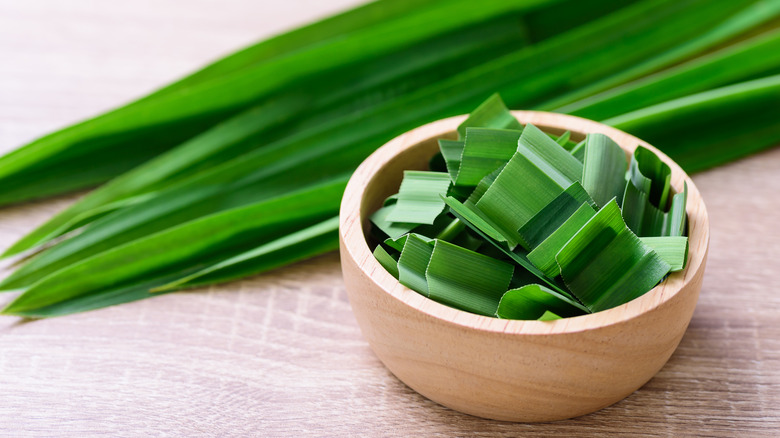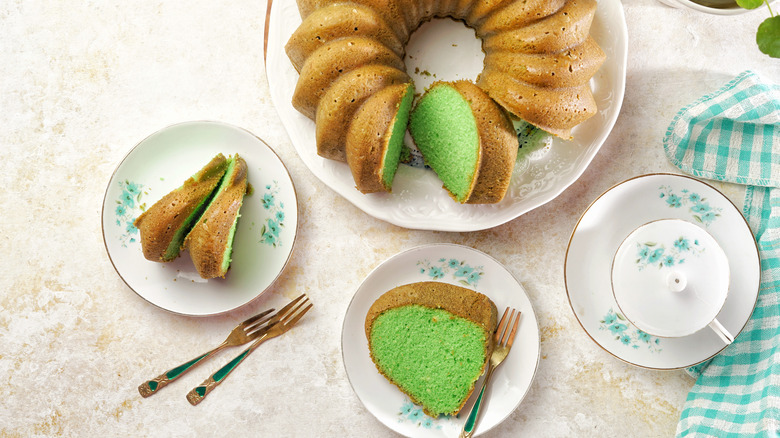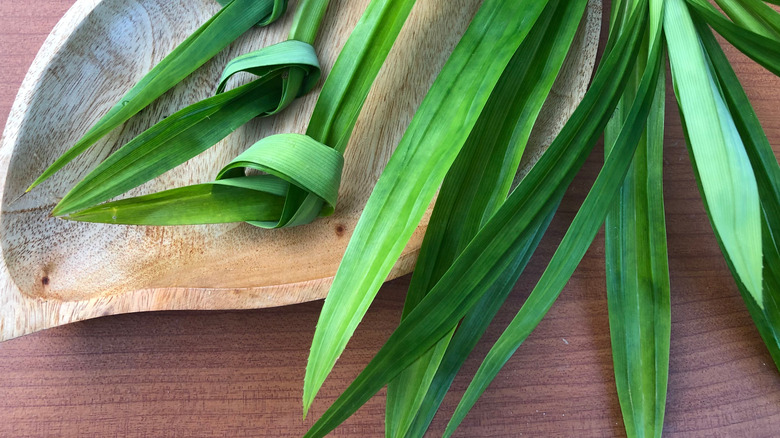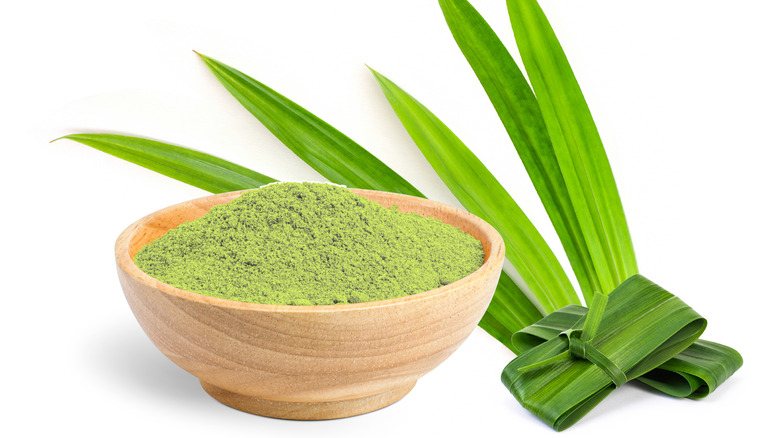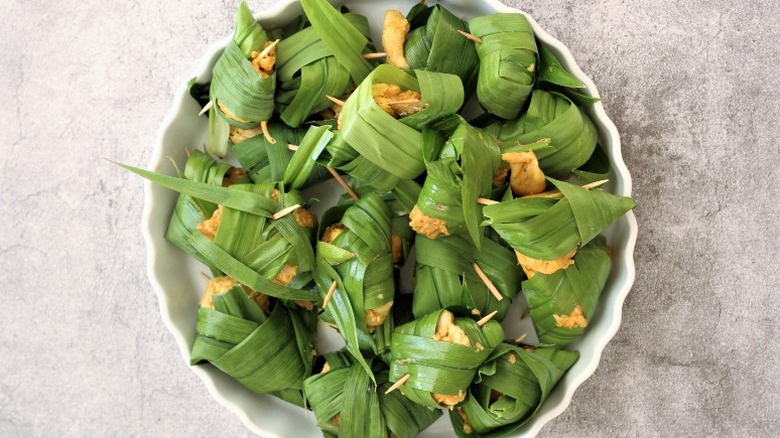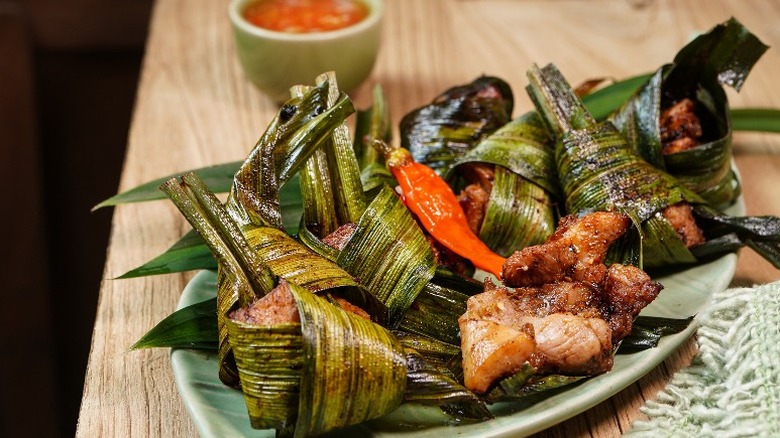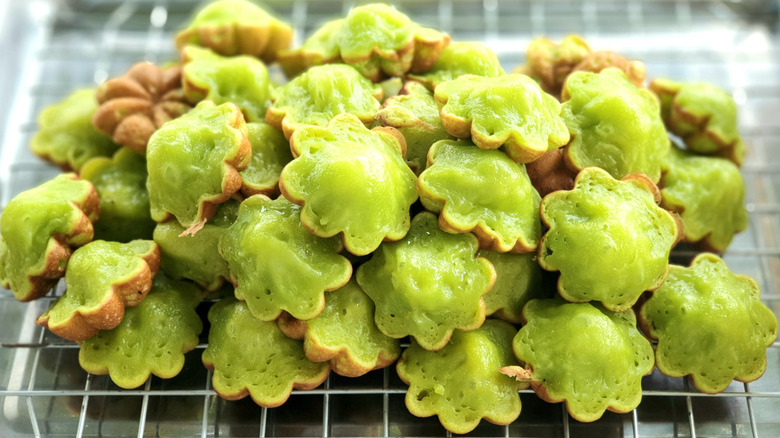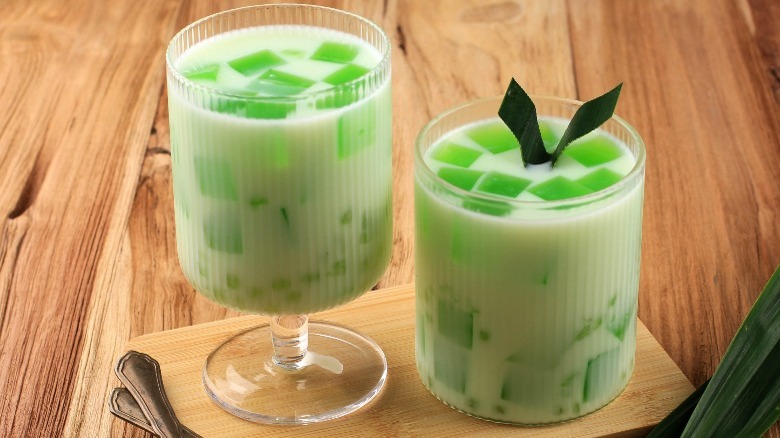What Is Pandan And What Does It Taste Like?
Imagine this sensation on your palate: A commingling of freshly cut grass and steamed rice, enhanced with rose, almond, and vanilla, with underlying notes of coconut. That's pandan (Pandanus amaryllifolius), a palm-like, cultivated plant with long, slender, spiky green leaves that are commonly used in Thai and Southeast Asian cooking (via The Spruce Eats).
Pandan has grown in popularity and is quickly becoming more and more common across the world. Culinary trendsetter Nigella Lawson compared its uses and popularity with other fads like matcha and avocado when she noted the spread of pandan usage across the United States and the United Kingdom (via The Times). There's no doubt that pandan is a delicious and exciting ingredient with many uses.
Maybe you recognize the flavor from a dish at your favorite Thai restaurant, or you've never tasted it before but are intrigued by the possibility of incorporating a new ingredient into your at-home cooking. Either way, we've got you covered. Read on to learn everything you need to know about pandan.
What is pandan?
Pandan is a culinary ingredient that refers to the leaves of a specific herbaceous plant that thrives in tropical climates, as well as the products made from these leaves. The leaves are long and oblong and vary from medium to large sizes. A regularly harvested plant will produce narrow leaves up to a meter in length that come to a point, and they are visually similar to the top of a pineapple plant.
The plant's name varies across languages. In English, we call it screwpine, while it is known as rampe, takonoki, daun pandan, bai toey hom, and chan xiang lan in Hindi, Japanese, Malaysian, Thai, and Mandarin, respectively. No matter what you call it, the leaves of the plant have become an important ingredient. Although the exact origin of pandan and its use as a culinary ingredient is unclear, it's indigenous to Southeast Asia, where it's extensively cultivated. In addition, the fresh and frozen leaves are sold in South India, Southeast Asia, Indonesia, Sri Lanka, and West New Guinea (via Specialty Produce).
How is pandan made?
Of course, in order for pandan to be available, the plant must be grown and its leaves cultivated widely for use. According to Specialty Produce, it is not typically found in the wild at this time. Still, it is planted and grown commercially, and the leaves are used to make different versions of the ingredient. As described by the manufacturer Blueboots Farm, the leaves can be dried and milled into a powder form. It also is common for the leaves to be made into a paste by pounding them, removing the most fibrous pieces, and adding a small amount of water. Elsewhere, pandan extract is made by grinding the leaves up and combining them with water, then straining the ground leaves out and collecting the resultant liquid.
These processes create pandan products that capture the desired flavor in a concentrated form. Indeed, a small amount of powder, extract, or paste goes a very long way when added to a recipe (via The Spruce Eats).
Powder vs. extract
Food 52 adds that there's more to pandan than the leaves. A few drops of pandan extract or a pinch of pandan powder not only adds a "grassy-sweet" flavor and aroma to a variety of sweet and savory dishes, but it turns an ordinary dish into one with a "glorious, green glow." While either powder or extract will work in most recipes calling for the ingredient, one may be more suitable depending on the type of dish you want to use it in.
When the leaves are dried and ground, pandan powder can be used to add natural green color and vanilla-like flavor to a variety of recipes, including cakes, cookies, macarons, muffins, and breads (via Blueboots Farm). Pandan powder is a great way to preserve the plant's colors and aroma and incorporate them into baked goods.
Pandan extract, on the other hand, is a great way to add flavor to liquid ingredients. It is an effective way to add a distinct layer of flavor to savory broths, stews, curries, and soups. It can also take center stage when mixed with coconut milk and steamed rice, as in the Malaysian dish nasi lemak (via Healthline).
What does pandan taste like?
Now, let's get down to the big question of our pandan ingredient guide: What exactly does pandan taste like? After all, its unique flavor is what makes it such an interesting ingredient. The simplest way to describe pandan's flavor is sweet. However, it has a complex and unique flavor profile that can't be captured so simply. It is most often compared to vanilla — Healthline describes it as vanilla with a grassy undertone and hints of coconut flavor. While it has a soft aroma, the flavor is strong, and it has floral and nutty elements that The Spruce Eats describes as a mix of "grassy" and "rose, almond, and vanilla, verging on coconut."
Fans of the ingredient on Quora described the flavor as tangy, citrusy, and delicate. They also noted that a lot of the experience of pandan comes from the distinct aroma and that when the ingredient is used in small amounts, the distinct grassy and floral scent adds a lot to a dish.
How to cook with pandan
Pandan has multiple culinary uses. Healthline explains that the leaves are often boiled or juiced and can be used to wrap and flavor meats and sticky rice. When pulverized, bruised, or raked with a fork, the leaves produce a vibrant emerald-green extract that's used in sweet and savory dishes. The Epicentre adds that pandan leaves are often wrapped around chicken, pork, rice, fish, and desserts before grilling, roasting, barbecuing, and steaming to enhance the flavor and aroma of the plant.
Saveur has many recipe suggestions, from making pandan-scented water with the steeped leaves to using the bright green liquid from the leaves in place of vanilla in cakes and breads. You can also add the leaves to a pot of rice (with some coconut milk, lemongrass, and turmeric), wrap them around pieces of chicken before steaming and frying, make pandan-coconut ice cream, and add leaves to your cocktails for a nutty finish.
For more recipe inspiration, check out Devour.Asia's pandan simple syrup — a sweet infusion that can be used in a variety of ways. In addition, What to Cook Today shares a popular, green-tinged pandan chiffon cake. And for countless pandan recipes, head over to Cookpad, where you'll find pandan's presence in puddings, cakes, breads, cookies, donuts, pancakes, and waffles.
Where to buy pandan
Saveur dubs pandan the "vanilla of Southeast Asia" and states that if you live near a Thai, Vietnamese, or Southeast Asian grocer, you should grab some fresh or frozen pandan leaves and go to town. But whether the leaves are packaged whole or cut up before being sold, be sure to inspect them before purchasing. In particular, fresh leaves should be green and crisp, not browning or beginning to shrivel. If the frozen leaves are discolored or covered in an excess of ice crystals, they are not good to use (via The Spruce Eats). Pandan paste, powder, and extract are also available to be purchased in Asian grocery stores. When buying these products, check the ingredient list — higher quality products will only use pandan leaves and water, while some brands may include different additives.
The leaves should be available year-round. If you purchase them fresh, you should wrap them in a damp cloth and store them in the vegetable drawer of the refrigerator so they will keep for a few days (via Specialty Produce). You can also freeze the leaves yourself. Can't get to an Asian market? No problem — you can find pandan leaves, extract, and powder online at various sources and have them delivered directly to your home (via Food 52).
Nutritional value of pandan
Pandan is usually used in smaller amounts, but it is important to consider all the nutritional value of the ingredient when using it. Pandan contains minerals like protein, iron, calcium, phosphorus, and fiber, and products made from the leaves do not contain fats. The high levels of iron are of note, as this mineral aids in circulation and counters low iron levels (via Healthline). The ingredient is also filled with beta carotene, a precursor to Vitamin A that has eyesight and immune system benefits.
Not much scientific research has been conducted on the benefits of pandan, but some studies have acknowledged its uses in non-Western medical practices as treatments for arthritis and inflammation, blood sugar, and oral health. Still, the studies that have been conducted have not evaluated the plant's effects directly on humans. Pandan also has mild laxative effects and should not be consumed in large amounts.
